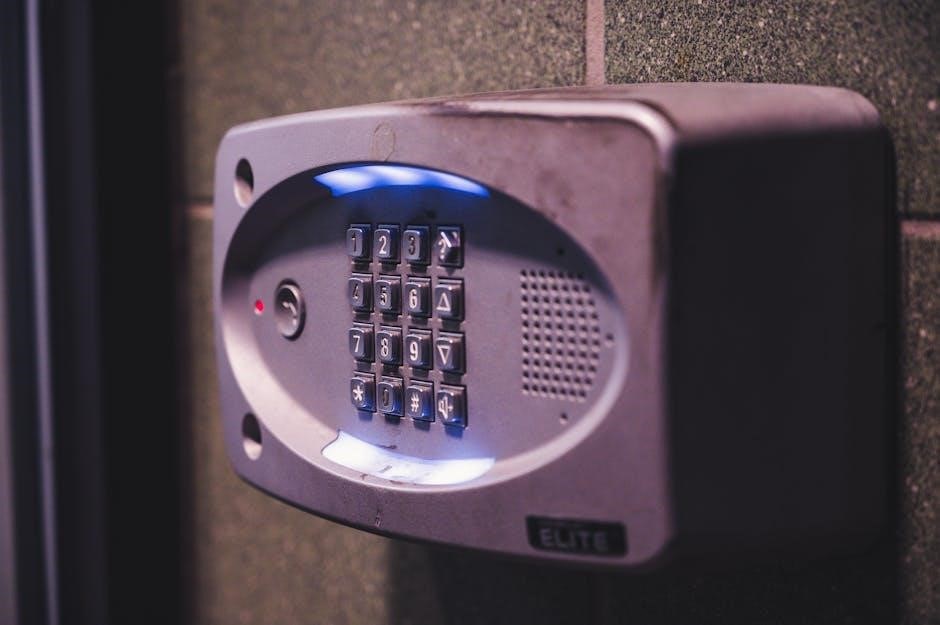Honeywell security pad manuals provide comprehensive guides for installation, configuration, and troubleshooting of various keypad models, ensuring optimal setup and maintenance for enhanced home or commercial security systems.
1.1 Overview of Honeywell Security Systems
Honeywell offers a range of advanced security systems designed for residential and commercial use. Their products include keypads like the 6150, 6160, and 6270 series, featuring fixed or touchscreens, voice capabilities, and high-security modes. These systems support wired or wireless integration, multiple security levels, and customizable settings, ensuring robust protection and user-friendly operation. Honeywell’s reputation for innovation and reliability makes their systems a top choice for modern security needs.
1.2 Importance of Reading the Manual
Reading the Honeywell security pad manual is crucial for understanding system operations, installation, and troubleshooting. It provides detailed instructions for arming/disarming, configuring settings, and resolving issues like battery problems or tamper alarms. The manual ensures optimal system performance, enhances security, and helps users navigate advanced features, such as high-security modes and custom settings, effectively.

Installation and Setup Guide
Install Honeywell security pads by mounting keypads, connecting wires, and syncing with control panels. Follow model-specific guides for 6150, 6160, and 6270 series for seamless setup.
2.1 Step-by-Step Installation Process
Begin by mounting the keypad securely on the wall or placing it on a flat surface. Connect the wires to the control panel, ensuring proper alignment of terminals. For wireless models, sync the keypad with the panel using the provided instructions. Refer to model-specific manuals for 6150, 6160, or 6270 series for precise wiring or pairing steps. Power on the system and test functionality to confirm successful installation.
2.2 Configuring the Security Pad
Configure the security pad by entering the installer code to access advanced settings. Set up user codes and adjust sensitivity levels for motion detectors. Enable voice prompts or high-security modes as needed. Sync wireless devices with the control panel and test all functions to ensure proper operation. Refer to model-specific manuals for detailed configuration steps tailored to your Honeywell 6150, 6160, or 6270 keypad.

Basic Operations and Features
Explore essential functions like arming/disarming the system, LCD display navigation, and emergency panic buttons. Features include voice prompts for user-friendly interaction and customizable alerts for enhanced security.
3.1 Arming and Disarming the System
To arm the system, enter your 4-digit user code and press the “Away” or “Stay” button. The LED will flash to confirm arming. Disarm by re-entering your code and pressing “Off.” Emergency panic buttons trigger immediate alarms. Voice prompts guide you through the process, while LED indicators show system status, ensuring a seamless and secure experience for users of all skill levels.
3.2 Understanding the Keypad Layout
The Honeywell security pad features a user-friendly interface with a numeric keypad, emergency panic buttons, and LED indicators. The 6150 model includes a 2-digit display for zone identification, while advanced models like the 6160 and 6270 offer alphanumeric or touchscreen displays. Buttons are clearly labeled for arming, disarming, and accessing menus. LED lights provide visual feedback for system status, ensuring intuitive operation for all users.
Advanced Security Features
Honeywell security pads offer high-security modes, encryption, and customizable settings to ensure robust protection. These features enhance system integrity and adaptability to diverse security requirements.
4.1 High Security Mode Activation
Enabling High Security Mode on your Honeywell keypad boosts system protection by exclusively recognizing encrypted devices. To activate, navigate to the security menu and enter ‘1’. This ensures all communications are secure, safeguarding against unauthorized access. However, disabling this mode allows the integration of non-encrypted devices, useful for older systems. Press the key to confirm and proceed, ensuring your security preferences are tailored to your needs for optimal protection.
4.2 Customizing Security Settings
Honeywell security pads allow users to tailor settings to their needs. Models like the 6160RF and 6150RF support custom user codes, access levels, and arming options. Users can navigate through the menu to adjust settings, such as enabling voice prompts or modifying zone configurations. Enter your code to save changes, ensuring a personalized and secure system that aligns with your specific security requirements and preferences for optimal protection.
Troubleshooting Common Issues
Resolve battery and connection issues by checking power sources and signal strength. Address tamper alarms by verifying system connections and ensuring proper installation for reliable operation.
5.1 Resolving Battery and Connection Problems
Identify low battery alerts by checking keypad notifications. Replace batteries with compatible types to avoid system malfunctions. Ensure secure connections between devices and panels. Restart systems after battery replacement. If issues persist, consult user manuals or contact technical support for further assistance;
5.2 Addressing Tamper Alarms
Tamper alarms occur when the system detects unauthorized interference. Check all connections and ensure devices are securely fastened. Verify keypad and panel communication. If issues persist, reset the system by entering your user code followed by the reset command; Consult the manual for specific reset procedures or contact technical support for further assistance.
Integration with Other Security Systems
Honeywell security pads integrate seamlessly with Honeywell panels and other systems, offering wireless and wired options for enhanced security and centralized control.
6.1 Compatibility with Honeywell Panels
Honeywell security pads are designed to work seamlessly with Honeywell panels, including the VISTA-20P and VISTA-21iP, ensuring reliable communication and advanced security features. Models like the 6160RF and 6150 are fully compatible with these systems, offering wireless and wired integration options for enhanced functionality. This compatibility allows for streamlined system operation and centralized control, making it easier to manage security across different zones and devices efficiently.
6.2 Wireless and Wired Integration Options
Honeywell security pads offer flexible integration options, supporting both wireless and wired connections. Wireless keypads, like the 5839, provide mobility without compromising functionality, while wired models ensure stable, high-speed communication. These integration options allow users to customize their security systems, ensuring compatibility with various Honeywell panels and devices for a robust and scalable security solution.
Model-Specific Guides
Guides for Honeywell models like 6160, 6150, 6270, and 6280 provide detailed instructions tailored to each keypad’s unique features, ensuring users can optimize their security system’s performance effectively.
7.1 Honeywell 6160 and 6150 Models
The Honeywell 6160 is a deluxe 32-character alpha keypad, offering advanced features like zone identification and customizable settings. The 6150, a fixed English keypad, provides essential security functions with simplicity. Both models ensure reliable performance, with the 6160 catering to users needing detailed zone control and the 6150 serving those requiring straightforward security management. Refer to the manual for specific configuration details to optimize their functionality for your security needs.
7.2 Honeywell 6270 and 6280 Series
The Honeywell 6270 features a graphic touchscreen, offering intuitive navigation and enhanced security monitoring. The 6280 series includes a touch center keypad with advanced integration capabilities. Both models provide robust security solutions, with the 6270 ideal for users seeking a modern interface and the 6280 series designed for seamless integration with other Honeywell panels, ensuring comprehensive security system control and monitoring. Refer to the manual for detailed setup and operation instructions.
Safety and Compliance Information
Adhere to safety precautions and comply with regulatory standards when installing or operating Honeywell security systems to ensure user safety and system reliability, as outlined in the manual.
8.1 System Safety Precautions
Always follow safety precautions when handling Honeywell security systems. Ensure proper installation and avoid tampering with components. Keep batteries away from children and dispose of them safely. Understand tamper alarms and LED indicators to maintain system integrity. Adhere to all safety guidelines to prevent accidents and ensure reliable operation, as detailed in the manual for optimal security and user protection.
8.2 Compliance with Security Standards
Honeywell security systems are designed to meet or exceed industry standards, ensuring reliability and performance. Adherence to global security regulations guarantees compliance with certifications and requirements. This ensures that your security setup aligns with legal and safety norms, providing a secure environment for users. Regular updates and adherence to standards maintain system integrity and effectiveness in safeguarding properties and assets effectively always.

Maintenance and Upkeep
Regular maintenance ensures optimal performance of Honeywell security pads. Clean keypads, check battery levels, and update firmware to keep systems reliable and secure over time.
9.1 Regular Maintenance Tips
Regular maintenance is crucial for Honeywell security pads. Clean the keypad surfaces with a soft cloth to prevent dust buildup. Check battery levels monthly and replace low batteries promptly. Ensure all connections are secure to avoid tamper alarms. Update firmware regularly to maintain system security and functionality. Schedule professional inspections annually for advanced diagnostics and repairs.
9.2 Updating Firmware and Software
Regular firmware and software updates are essential for Honeywell security pads to ensure optimal performance and security. Always download updates from Honeywell’s official website or through authorized dealers. Follow the manual’s instructions to perform updates, typically involving a USB connection or wireless update feature. Ensure the system is powered on and avoid interruptions during the update process to prevent system malfunctions.
User Codes and Access Levels
Honeywell security systems allow users to create and manage unique access codes, ensuring personalized security. Different access levels can be set for users, enhancing system customization and control.
10.1 Creating and Managing User Codes
Creating and managing user codes on Honeywell security pads involves entering a master code to access the programming menu. Users can assign unique 4-6 digit codes to individuals, ensuring secure access. Codes can be temporary or permanent, with options to delete or modify them as needed. This feature allows system administrators to maintain tight control over who can arm, disarm, or access specific areas of the security system.
10.2 Setting Access Levels for Different Users
Honeywell security pads allow administrators to set access levels, granting users permissions such as arming/disarming, viewing event logs, or bypassing zones. Access levels can be customized to ensure only authorized individuals can perform specific actions, enhancing system security. Administrators can assign these levels through the keypad menu, providing flexibility while maintaining control over system functionality and user privileges.

Emergency Procedures
Honeywell security systems include emergency procedures like responding to false alarms and system resets. Users can enter specific codes to silence alarms or restore default settings quickly.
11.1 Responding to False Alarms
Responding to false alarms on Honeywell security systems involves entering your user code and pressing the appropriate key to silence the alarm. This process ensures quick resolution and minimizes disruptions. The system allows users to clear false alarms efficiently, maintaining security without unnecessary alerts. Properly addressing false alarms helps prevent unnecessary emergency responses and keeps the system reliable for actual threats. Regularly reviewing alarm triggers can also reduce false alarm occurrences.
11.2 System Reset Procedures
Resetting a Honeywell security system involves entering the master code followed by a specific command, such as *94 or 1-2-3-4-1-2, to restore factory settings. This procedure is ideal after addressing false alarms or system malfunctions. Ensure all zones are secure before resetting to avoid unintended triggers. Always refer to the manual for model-specific instructions to prevent configuration loss. Resetting ensures the system operates correctly and efficiently. Regular resets can maintain optimal performance.
Refer to Honeywell’s official website for comprehensive guides, customer support, and authorized dealers to ensure optimal system performance and compliance with security standards.
12.1 Final Tips for Optimal Use
Regularly update firmware and software to ensure compatibility and security. Test arming/disarming procedures monthly. Store user manuals securely for quick reference. Use genuine Honeywell parts for repairs. Train all users on emergency protocols. Schedule annual professional inspections for optimal performance. Keep backup power sources ready to prevent system downtime. Always follow manufacturer guidelines for troubleshooting and maintenance.
12.2 Where to Find Additional Support
Visit Honeywell’s official website for downloadable manuals, troubleshooting guides, and FAQs. Contact Honeywell support directly via phone or email for personalized assistance. Explore authorized distributors for certified products and expert advice. Engage with online forums and communities for peer-to-peer solutions. Utilize Honeywell’s mobile app for real-time system management and updates. Refer to certified dealers for hands-on training and advanced system integration.
